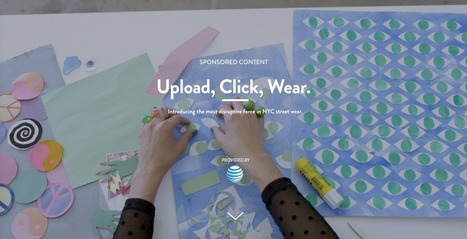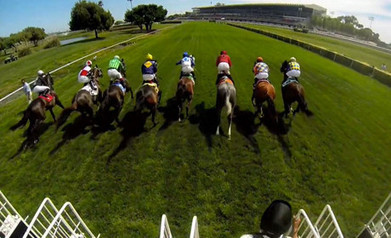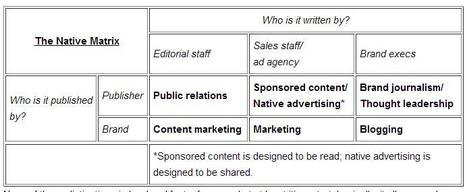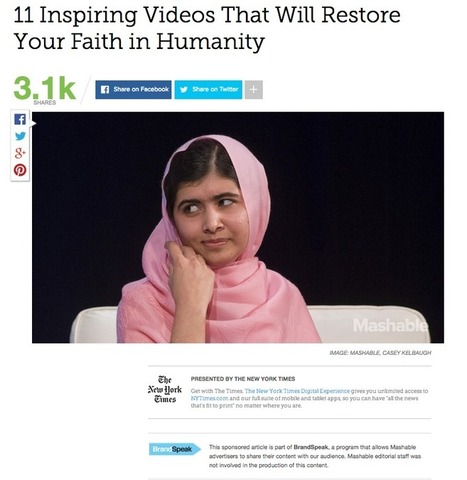 Your new post is loading...
 Your new post is loading...
Polar tested different ad formats including image-based content (graphics, image galleries, and slide shows), article-based content, and video-based content. It tested more than 30 pieces of content, with each type tested by a minimum of 1,000 people via desktop, mobile, and both. Among the findings of the study, conducted in March 2017: --Consumer awareness of a brand increased to 69% after engaging with branded content, while purchase intent was 51%. The study also used a control group with no branding. --Incorporating companion display ads next to branded content improved purchase intent by 17% and didn’t have a negative impact on brand perception --Imagery (infographics, image galleries, and slide shows) performed the best among content formats. And notably, video isn’t always needed to tell the story. However, imagery outperformed articles by 11%. "We found that consumers responded a bit more favorably when there was less obvious branding,” Bella said....
How do readers feel about all of this? Most research suggests that audiences prefer sponsored posts to banner ads, but they also appreciate it less than regular content. If you’ve come across sponsored content before, you’ll probably understand how it can be both confusing and frustrating.
In 2015, as brands continue to pour dollars into these projects, publishers will keep growing their resources and improving their output. Consequently, audiences will begin to realize that content underwritten by brands can be meaningful too.
Let’s look at some publishers that are currently leading the pack in terms of content quality, formatting and design, and reader experience:...
Doug Scott’s recent departure from OgilvyEntertainment, the successful unit he founded eight years ago, has raised questions about whether its WPP parent might fold it into another corporate entertainment sibling like media agency Mindshare Entertainment or GroupM Entertainment at the operating level. While Ogilvy execs say that isn’t in the works, such speculation still begs the larger industry question: As media, creative and PR agencies—along with production companies—vie to lead the growing number of marketer content initiatives, where should responsibility for branded storytelling reside? With traditional advertising becoming less profitable, everyone, obviously, is scrambling for these new income sources.
On the creative agency front, proponents argue that without a great concept born from understanding a brand’s narrative, long-form storytelling doesn’t hold an audience’s attention and justify the media expense....
Native advertising is paid content that matches a publication’s editorial standards while meeting the audience’s expectations.
Think Captain Morgan’s campaign on BuzzFeed in general, their 15 Things You Didn’t Know About 15 Captains, Commanders And Conquerors article in particular.
First off, the theme of the article matches the brand’s values: Captain Morgan was a real live pirate who thrived on adventure and raw conquest — a theme not too foreign to BuzzFeed readers.
Moreover, the article matches the editorial standards of BuzzFeed: a list with big images and short, quirky copy — a format their audience expects....
What is the 'best' consumer brand of 2013? Depends how you measure it....
The research reports that being perceived as a simpler brand results in higher customer retention and recommendation rates. 75% of people said when they perceived a brand to be simple, they would recommend that brand to family and friends.
The report also argues that customers are willing to pay a premium for simpler experiences with companies.
Providing simple, clear messages brands also create a better workplace for employees, encouraging innovation and creativity. Results showed 51.2% of respondents employed by ‘simple’ companies believe they are rewarded for being innovative, compared to just 6% at complex companies...
We speak to two of the people involved in creating the news outlet's latest Snowfall-like immersive multimedia project....
Last week The New York Times website published a story called The Jockey, followed by publication in the sports section of the print edition on Sunday.
The Jockey is the latest immersive or multimedia reading experience created by the news outlet that brought us Snow Fall. The Jockey tells the story of Russell Baze, the first North American jockey to ride in 50,000 races, and does so through long-form text, video and moving graphics.This immersive story has a sponsor. Some have interpreted this as native advertising or sponsored content, and AdAge writes that these custom ad units are "designed to better fit the new environment" than the advertising within Snow Fall...-
Steve Rubel, our chief content strategist, and I have been visiting with media companies for the past three months to understand more fully the opportunity in paid content for PR firms....
It is clear that media companies are now willing, even eager, to explore the third way to revenue, beyond circulation and classic advertising, to a new hybrid model, which falls somewhere between the old advertorial and the novel sponsored content. The new mantra at Edelman is that the paid ought to support the earned and owned content, to make it work harder and more intelligently than a classic media buy that stands on its own. We need to flip the traditional model on its head, whereby media buying agencies act as the intermediary between client and media, extracting the best financial deal on the basis of mass purchasing power.
Our advantage will never be scale in buying; rather we will have a more intelligent approach, a smart bomb instead of multiple bomber runs. But to do this, we will have to be given access to some advertising funds to be used at our discretion when a story seems to be taking off in popularity. We also need some money to initiate a surround-sound approach from conference sponsorship to proprietary content creation to online discussion moderation and aggregation of related content. So clients will have to entrust us with some of the paid media funds, then hold us to even higher standards for delivery of results....
Jay Rosen asks, reasonably, that people start drawing useful distinctions between buzzy terms like content marketing, sponsored content, native advertising, and even brand journalism. Here’s my stab at it:
The Native Matrix - Who is it written by? Editorial staff, Sales staff, ad agency, Brand execs - Who is it published by? Publisher: Public relations, Sponsored content/ Native advertising, Brand journalism/Thought leadership or Brand: Content marketing, Marketing, Blogging *Sponsored content is designed to be read; native advertising is designed to be shared. None of these distinctions is hard and fast, of course, but at least it’s a start; basically, it all comes down to who writes the content in question....
How many banks can you think of that put so much faith in the power of brand content that they began producing award-winning television and video shows on a daily basis? No matter how hard you try, it’s likely you’ll only come up with one: Jyske (pronounced You-ska) Bank. Jyske Bank has created one of the most high-tech, in-house television production studios in Denmark. In fact, the company refers to itself as both a bank and a media company.Jyskebank.tv produces amazing financial programming, as well as compelling stories that the bank believes are relevant to its core audience of younger consumers and small enterprises. Jyske’s brand content program is made up of two key values: Remaining true to the organization’s guiding vision, which it calls “Our Foundations“Telling good stories...
ILate last year, yet another industry buzzword emerged: “Native Advertising.” The term has received a lot of media attention and excitement from brands, rich-media companies and publishers alike, and after cutting through the hype, one question still remains: What does it actually mean? At the basic level, native ads are paid experiences that are complementary to the platform and content in which they are presented. While examples include Sponsored Stories on Facebook or Sponsored Tweets on Twitter, this doesn’t quite do the term justice. Truly native advertising takes things one step further, referring to seamlessly integrating brands into the medium, so much so that the consumer gets more value from the advertising as part of a greater content consumption experience. As Peter Kafka wrote in a recent article, native advertising is about “selling stuff that people want to look at.” This is key to get people to start thinking about brands, without making the ad blatant or disruptive. This can happen on all media from broadcast to digital, print to mobile, using technologies and platforms that engage with native in mind....
Many brands today are turning to storytelling in branding as a strategy to connect with consumers. These curated speeches demonstrate how this particular strategy benefits different brands and how it can be implemented in different industries.
Former Businesweek reporter Steve Wildstrom has worked as a “corporate reporter” for Nvidia and Cisco, Giselle Abramovich writes. Those are people “who work inside the company and produce media like blog posts, videos, webinars and more,” she writes. The twist is this path isn’t exactly like public relations. Brands are realizing, to a degree, that if they truly want to be publishers they can’t just have people churning out corporate boilerplate. They’re loosening the reins a bit in a bid to attract actual reporters. Wildstrom says he was worried how his colleagues would react, but “Cisco’s editorial policy is to forbid its writers from covering the company or its competitors,” Abramovich notes. Wildstrom, who covers tech, tells her he steers clear of pieces he can’t report honestly: “That’s how I have chosen to handle it. If I can’t be honest, I won’t write it,” he says....
Marketers often THINK they know exactly what their communities want, but soon find that their content strategy actually prompts users to click unlike or unfollow.
It is not always blatantly obvious why this happens, however a recent study by eMarketer.com has shed some light on the reasons why social media users decide to disconnect from a brand. Let’s take a closer look at the top 5 reasons why users choose to cut ties with brands on social media channels.
|
Have you been thinking about turning your organization's communications into your version of a metropolitan newspaper newsroom? Here are some examples you should look at.
Those 11 inspiring videos are all original feel-good New York Times productions, and as Digiday’s Lucia Moses noted this morning, the ad is intended to drive subscription signups forThe Times, with a prominent call to action at the top of the piece imploring readers to “Get with The Times.
”While this may seem bizarre and a little too meta for this early in the morning, it’s actually a shrewd move by The Times to grow their audience. Clearly, they’ve identified Mashable readers as potential Times readers and subscribers, and as a result, they’ve come to them with a month-long campaign of branded posts._
The Times also punched up the titles of the individual videos for a Mashable audience. “Tattoo Artist Gives Breast Cancer Survivors Nipples and Hope” was originally titled “The Nipple Artist,” and “Can Your Grandma Pump Iron Like This?” was called “Shirley and the Bodybuilder.”...
At a time when good-paying freelance assignments are harder to come by, many journalists are heeding the call of native advertising, where the pay is decent and the work is steady. But there’s a cost. Many worry about the impact on their credibility as a journalist. Some are even finding they aren’t so welcome back in newsrooms once they work for the business side.
In the latest in Digiday’s “Confessions” series, we talked to a veteran freelance writer who has written for top women’s magazines and other national publications about the dark side of native. In this case, the journalist was working for a publisher’s content studio, which assigned stories a given client wanted written....
Ask any lifestyle magazine publisher how they’re making up for declining print revenue, and chances are they’ll mention e-commerce. But while countless publishers are struggling to drive dollars via online shopping, there’s a growing number of e-commerce companies moving in the opposite direction.
In recent months, customers of online-only retailers like Rent the Runway, JackThreads and Birchbox have received catalogs—yes, those old-school, printed booklets—in their mailboxes, while flash sale site One Kings Lane has been sending out “magalogs” combining decorating tips with photographs of rooms populated by the site’s ever-changing inventory....
Here's why native advertising is the opposite of porn.It's a do-over from the past 20 years of online advertising. It's a bold new path for brands and publishers. It's the hoary advertorial dressed up in 21st-century clothes.
Native advertising is at least some of these things. Top publishers and brands met in Washington, D.C., on Wednesday for an American Press Institute summit to determine whether it is also the industry's salvation.
Fittingly enough, the host of the event was Atlantic Media, whose flagship publication, The Atlantic, introduced the native-advertising industry's first scandal when it ran an article entitled “David Miscavige Leads Scientology to Milestone Year" on its site in January. Commissioned by the Church of Scientology, the article was labeled as advertising, but raised hackles among fans and critics. A day later, Atlantic Media issued a three-word apology: "We screwed up."...
A recent study conducted by BIA / Kelsey predicts that by 2017, social media advertising spending will have reached 11 billion dollars; a significant growth compared to 4.7 billion dollars last year. Business owners and investors are excited with this huge growth, but according to Ian Schafer, chief executive of Deep Focus, a full-service, interactive marketing agency, the ad agency may not be ready to deliver when 2017 comes.
Schafer points out the study conducted by YouGov, which showed that last year, only one out of 20 users in Facebook clicked at least one advertisement. In addition, less than ten percent of Facebook users think that targeted ads are relevant to their needs. One reason why Facebook ads have such a negative impact on users is because they appear to march into our private social media space, sending us spam messages, mobile banners, occupying the right side of our profiles, forcing us to watch 15 second video ads, and more....
While there are major differences between content marketers and journalists, the two groups do have one important thing in common: They want to make their writing the best that it can possibly be. This requires a whole lot more than just writing nice turns of phrase. It requires doing research, reading widely, and interacting with others. So with that in mind, we’ve outlined 5 things that content marketers can learn from journalists...
Articles in a series on Mashable.com called “What’s Inside” looked for all the world like the hundreds of other articles on the digital media site. But journalistically, they were something very different.
The articles, about technology topics in a wide variety of products, including modems and theHubble Space Telescope, were paid for by Snapdragon, a brand of processor chip made by Qualcomm, and the sponsor of the series. Most were even written by Mashable editorial employees.
An article on Google Glass technology was shared almost 2,000 times on social media, indicating that readers may not have cared, or known, if it was journalism or sponsored content, although the series was identified as such. Advertisers and publishers have many names for this new form of marketing — including branded content, sponsored content and native advertising. Regardless of the name, the strategy of having advertisers sponsor or create content that looks like traditional editorial content has become increasingly common as publishers try to create more sources of revenue....
Inbound marketing – or combining different online marketing processes such as SEO, content marketing, social media and conversions – has been one of the most effective ways to hit a site’s various business goals in one go, like driving more specifically targeted traffic, improving revenue and/or building a stronger brand mind share. Aside from involving practices that is measurable, utilizing inbound marketing as an approach to reach a business’ target audience (without disrupting their online activities) has proven itself to be very effective in terms of scaling and growing businesses in a shorter span of time. Some of the most known advantages of implementing these practices as a whole are: -Processes involved are cost-efficient and can be implemented in-house. -It works on almost any size of site/business and on almost any industry. -Can help cumulatively achieve business goals (like constantly generating traffic, leads, conversions), through all the past and current efforts done to improve the brand/site. There are so many tactics that you can choose inside the inbound marketing realm that can really help your business grow. Although, in this post, I’ve chosen to highlight a few strategies which I believe can really grow both traffic and conversions when implemented continuously....
I was recently asked a provocative question: “What experiences or insights have shaped your views on brand and reputation management in today’s business environment?” This is a great question and the more I thought about it, the clearer the answer(s) became. 1. The first insight reflects the The Changing Role of Influence. There is a great quote by Gary Hamel, who says “Influence is like water. Always flowing somewhere.” This is very true in today's business environment as new sources of influence are forming around our companies and industries at an extremely rapid pace....
I had a wonderful time presenting to the attendees of CMI’s recent webinar, Brandscaping and the New Content Marketers. (For those of you who attended, I’m sorry about my cellular connection… I know it made it difficult in those first five minutes.) The webinar generated 55 questions from our intrigued, interested, and extremely intelligent audience. We only got to four or five of those questions in the time allotted, so I offered to answer 11 of the questions that we were not addressed....
Your content plan doesn’t stop at keyword research. Without context, they’re just words that only provide the first step.
|



 Your new post is loading...
Your new post is loading...


































Does branded content really work? Research says yes and that's great news for marketing.